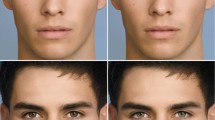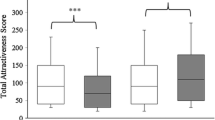Abstract
Human males provide facultative paternal investment to their offspring; that is, the male care is not necessary for the survival of his offspring. It is expected that the degree of male investment (1) increases with growing paternity certainty, (2) increases when investment increases the survival and later reproductive prospect of offspring and (3) declines when there are opportunities to mate with multiple females. Using a large sample of adult offspring and their fathers (n = 245), we first investigated the role of two factors possibly involved in the assessment of paternity and subsequently regulating the level of paternal investment: (a) father–child facial resemblance and (b) assortative mating for eye colour. Second, because mating opportunities are inversely related to paternal investment, we also investigated how male facial attractiveness (a cue of mate opportunities) correlates with paternal investment. In line with paternal investment theory, male investment positively correlated with offspring facial resemblance. However, paternal investment were neither higher among blue-eyed couples, nor there were preferences of blue-eyed men to marry with blue-eyed women. Moreover, father facial attractiveness was unrelated to paternal investment. These results indicate that resemblance between offspring and their fathers still plays an important role in paternal investment decision later in offspring’s life.



Similar content being viewed by others
References
Alvergne A, Faurie C, Raymond M (2007) Differential facial resemblance of young children to their parents: who do children look like more? Evol Hum Behav 28:135–144
Alvergne A, Faurie C, Raymond M (2009) Father–offspring resemblance predicts paternal investment in humans. Anim Behav 78:61–69
Alvergne A, Faurie C, Raymond M (2010) Are perception of offspring facial resemblance and parental investment decisions based on actual phenotypic similarities? Mother’s and father’s perspectives. Evol Hum Behav 31:7–15
Anderson KG (2006) How well does paternity confidence match actual paternity? Evidence from worldwide nonpaternity rates. Curr Anthropol 47:513–519
Anderson KG, Kaplan H, Lancaster J (1999a) Paternal care by genetic fathers and stepfathers I: reports from Albuquerque men. Evol Hum Behav 20:405–431
Anderson KG, Kaplan H, Lam D, Lancaster J (1999b) Paternal care by genetic fathers and stepfathers II: reports by Xhosa high school students. Evol Hum Behav 20:433–451
Apicella CL, Marlowe EW (2004) Perceived mate fidelity and paternal resemblance predict men’s investment in children. Evol Hum Behav 25:371–378
Apicella CL, Marlowe FW (2007) Men’s reproductive investment decisions, mating, parenting, and self-perceived mate value. Hum Nat 18:22–34
Bryn H (1920) Researches into anthropological heredity: I. On the inheritance of eye-colour in man; II. The genetical relation of index cephalicus. Hereditas 1:186–212
Burch RL, Gallup GG Jr (2000) Perceptions of paternal resemblance predict family violence. Evol Hum Behav 21:429–435
Clutton-Brock TH (1991) The evolution of parental care. Princeton University Press, Princeton
Daly M, Wilson M (1982) Whom are newborn babies said to resemble? Ethol Sociobiol 3:69–78
Daly M, Wilson M (1998) The truth about Cinderella: a Darwinian view of parental love. Yale University Press, New Haven
DeBruine LM (2004) Resemblance to self increases the appeal of child faces to both men and women. Evol Hum Behav 25:142–154
Fox GL, Bruce C (2001) Conditional fatherhood: identity theory and parental investment theory as alternative sources of explanation of fathering. J Marriage Fam 63:394–403
Geary DC (2006) Coevolution of paternal investment and cuckoldry in humans. In: Shackelford TK, Platek S (eds) Female infidelity and paternal uncertainty. Cambridge University Press, New York, pp 14–34
Geary DC, Vigil J, Byrd-Craven J (2004) Evolution of human mate choice. J Sex Res 41:27–42
Hamilton WD (1963) The evolution of altruistic behavior. Am Nat 97:354–356
Heath KM, Hadley C (1998) Dichotomous male reproductive strategies in a human polygynous society: mating versus parental effort. Curr Anthropol 39:369–374
Houston AI (1995) Parental effort and paternity. Anim Behav 50:1635–1644
Houston AI, McNamara JM (2002) A self-consistent approach to paternity and parental effort. Philos Trans R Soc Lond B 357:351–362
Houston AI, Székely T, McNamara JM (2005) Conflict between parents over care. Trends Ecol Evol 20:33–38
Jokela M (2009) Physical attractiveness and reproductive success in humans: evidence from the late 20th century United States. Evol Hum Behav 30:342–350
Kokko H (1998) Should advertising parental care be earnest? Proc R Soc Lond B 265:1871–1878
Laeng B, Mathisen R, Johnsen JA (2007) Why do blue-eyed men prefer women with the same eye color? Behav Ecol Sociobiol 61:371–384
Little AC, Jones BC, Penton-Voak IS, Burt DM, Perrett DI (2002) Partnership status and the temporal context of relationships influence human female preferences for sexual dimorphism in male face shape. Proc R Soc Lond B 269:1095–1100
Magee SE, Neff BD (2006) Temporal variation in decisions about parental care in bluegill Lepomis macrochirus. Ethology 112:1000–1007
Magrath MJL, Komdeur J (2003) Is male care compromised by additional mating opportunity? Trends Ecol Evol 18:424–430
Marlowe F (1999) Male care and mating effort among Hadza foragers. Behav Ecol Sociobiol 46:57–64
McLain DK, Setters D, Moulton MP, Pratt AE (2000) Ascription of resemblance of newborns by parents and nonrelatives. Evol Hum Behav 21:11–23
Møller AP, Thornhill R (1998) Male parental care, differential parental investment by females and sexual selection. Anim Behav 55:1507–1515
Neff BD (2003) Decision about parental care in response to perceived paternity. Nature 422:716–719
Oda R, Matsumoto-Oda A, Kurashima O (2005) Effects of belief in genetic relatedness on resemblance judgments by Japanese raters. Evol Hum Behav 26:441–450
Platek SM, Burch RL, Panyavin IS, Wasserman BH, Gallup GG Jr (2002) Reactions to children’s faces: resemblance affects males more than females. Evol Hum Behav 23:159–166
Rhodes G, Simmons LW, Peters M (2005) Attractiveness and sexual behavior: does attractiveness enhance mating success? Evol Hum Behav 26:186–201
Schacht M, Richter-Appelt H, Schimmelmann BG (2007) Der fragebogen zur eltern-kind-beziehung für kinder: grundlagen und erste ergebnisse. Psychother Psych Med 57:36–144
Sear R, Mace R (2008) Who keeps children alive? A review of the effects of kin on child survival. Evol Hum Behav 29:1–18
Thornhill R, Gangestad SW (1994) Human fluctuating asymmetry and sexual behaviour. Psych Sci 5:297–302
Todd PM, Penke L, Fasolo B, Lenton AP (2007) Different cognitive processes underlie human mate choices and mate preferences. Proc Natl Acad Sci USA 104:15011–15016
Trivers RL (1972) Parental investment and sexual selection. In: Campbell B (ed) Sexual selection and the descent of man. Aldine, Chicago, pp 136–179
Von Hippel FA (2000) Vigorously courting male sticklebacks are poor fathers. Acta Ethol 2:83–89
Weeden J, Sabini J (2007) Subjective and objective measures of attractiveness and their relation to sexual behavior and sexual attitudes in university students. Arch Sex Behav 36:79–88
Widding A (2007) Paternal kin discrimination: the evidence and likely mechanisms. Biol Rev 82:319–334
Zvoch K (1999) Family type and investment in education: a comparison of genetic and stepparent families. Evol Hum Behav 20:453–464
Acknowledgement
We would like to thank two anonymous referees for valuable improvements and insightful comments on earlier versions of this paper. The project was partially supported by KEGA 3/7454/09, VEGA1/0155/08 and VEGA 2/0009/09.
Author information
Authors and Affiliations
Corresponding author
Rights and permissions
About this article
Cite this article
Prokop, P., Obertová, Z. & Fedor, P. Paternity cues and mating opportunities: what makes fathers good?. acta ethol 13, 101–107 (2010). https://doi.org/10.1007/s10211-010-0079-0
Received:
Revised:
Accepted:
Published:
Issue Date:
DOI: https://doi.org/10.1007/s10211-010-0079-0




